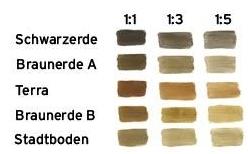Painting with the colours of the earth (D / E / CZ)
Application - Working with the colors of the earth
Preparation
The preparation of the colors and their use is very simple. It takes only a few empty containers used for mixing the colors. As a binder is used, for example glue.
Mix
Take one level tablespoon of pigment and mix it with the appropriate amount of glue. To have an optimal color for painting, it is necessary, pigment and glue mix intensively. The more glue is used, the brighter the colors. Of course, the colors blend well with each other (see color table). If the mixture is too thick, it is advisable to attach a little water gradually until you reach the desired consistency for painting.
Creative possibilities
With the coarser soil particles can be interesting effects: Spread the drawing paper with glue (thin layer), and then sprinkle the coarse soil particles over it. After the glue has dried, the excess soil particles can be removed with a brush.
Nature in the picture!
Another creative option is the use of natural materials. Freshly picked plants can be preserved with varnish and thus maintain their original color. Dried leaves can also be processed directly.
To work is the best one bristle brush. After painting this must necessarily be carefully cleaned, as it otherwise bonded. The dry season is approximately one hour!
Key facts about the production and composition of earth tones
Here an article anteasen. And the content is included below then total in this article:
Black soil
The dark color indicates a high proportion of humus in the soil. Humus is organic material from dead plant parts, composed of dead organisms and their conversion and degradation products.
Brown soil
Those in the brown earth soils A and B dominant yellow-brown earth, brown or orange colors are caused by, in the soil in various mineral forms abundant iron. The more orange the soil is, the higher the proportion of iron oxides. The mineral was 1806, in honor of the German poet Johann Wolfgang von Goethe, goethite, named, as Goethe was also an avid mineral collector.
Red soil
The red colors in the soil are also present in the soil caused by the iron. However, results from a warmer climate and less water in the soil one other mineral form of iron oxide - hematite. As the red coloring mineral hematite is very stable, such a base in Central Europe represent a relic of the subtropical to tropical climate 60 million years ago.
Light soil
High of lime and gypsum in the soil color the floor is white to beige. Limestone was removed from the material during the ice ages by ice, water and wind, and transported by the wind. This bright material is now often the source material for soil formation in Lower
What are the characteristics of the soil?
Black earth
The humus forms, with the mineral components in soil stable aggregates, which are a very good soil structure for crop growth. Furthermore, can save a lot of humus and release nutrients to the plants. The black color absorbs the solar radiation and thereby accelerated, especially in the spring, the growth of crops.
Brown earth
Depending on the thickness can vary fertile brown soils.
City ground
Fine sediments such as loess, a very good source material make for fertile soils. The location of the land in the city but that it is not used as a field site, but serves as a parking lot and built.
At what depth you will find the material?
Black earth
Dead plants are converted into humus at the surface, so the top inch (the top soil horizon) are dark in color mostly by higher humus shares.
Brown soil A and B
The weathering of iron found in the humus-horizon at a depth of about 10 cm instead of - 20. However, this is strongly influenced by parent material, the use and power of the A-horizon dependent.
Terra
The weathering of iron is in the B horizon at a depth cm instead of from about 10-20, even if the material were already millions of years ago (Tertiary).
City ground
There's been in the city of humus was often lost or removed, the bright material is from a few cm deep.
Association BIENE
(Boden- Bioenergie- und Nachhaltigkeits Netzwerk NÖ|EU)
Ing. Klemens Rybaczek
Braiten 5
A-3153 Eschenau
Email: office@biene-netzwerk.at













